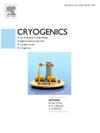A helium isotope separation cryostat with an entropy filter cooled by a G-M cryocooler
IF 1.8
3区 工程技术
Q3 PHYSICS, APPLIED
引用次数: 0
Abstract
To obtain ultra-high purity 4He, a helium isotope separation cryostat including an entropy filter cooled by a G-M cryocooler was constructed. This cryostat provided possibility for continuous separation of helium isotopes. The entire separation process comprised two stages determined by the state of helium flow through the entropy filter: the startup stage and the steady stage. In this paper, the separation effect under these two stages has been studied, with 3He concentration being tested by Helix SFT™ Mass Spectrometry. The concentration of 3He were , and for the feed helium gas, the startup stage and the steady stage. The results indicated that the concentration of 3He separated in the steady stage decreases by two orders of magnitude, and the separation effect of the startup stage is inferior to that of the steady stage. Additionally, a detailed analysis of 3He diffusion and 4He superfluid flow is presented, along with potential advancements in helium isotope separation cryostat that could benefit future industrial applications.
一个氦同位素分离低温恒温器与熵过滤器由一个G-M制冷机冷却
为了获得超高纯度的4He,构建了一个包含熵过滤器的氦同位素分离低温恒温器,该低温恒温器由G-M制冷机冷却。该低温恒温器为氦同位素的连续分离提供了可能。整个分离过程包括两个阶段:启动阶段和稳定阶段,这两个阶段是由氦通过熵过滤器的流动状态决定的。本文研究了这两个阶段的分离效果,并采用Helix SFT™质谱法测定了3He浓度。进料氦气、启动阶段和稳定阶段的3He浓度分别为3.31×10-8、6.39×10-10和2.41×10-10。结果表明,稳定阶段分离的3He浓度下降了两个数量级,启动阶段的分离效果不如稳定阶段。此外,还详细分析了3He扩散和4He超流体流动,以及氦同位素分离低温恒温器的潜在进展,这些进展可能有利于未来的工业应用。
本文章由计算机程序翻译,如有差异,请以英文原文为准。
求助全文
约1分钟内获得全文
求助全文
来源期刊

Cryogenics
物理-热力学
CiteScore
3.80
自引率
9.50%
发文量
0
审稿时长
2.1 months
期刊介绍:
Cryogenics is the world''s leading journal focusing on all aspects of cryoengineering and cryogenics. Papers published in Cryogenics cover a wide variety of subjects in low temperature engineering and research. Among the areas covered are:
- Applications of superconductivity: magnets, electronics, devices
- Superconductors and their properties
- Properties of materials: metals, alloys, composites, polymers, insulations
- New applications of cryogenic technology to processes, devices, machinery
- Refrigeration and liquefaction technology
- Thermodynamics
- Fluid properties and fluid mechanics
- Heat transfer
- Thermometry and measurement science
- Cryogenics in medicine
- Cryoelectronics
 求助内容:
求助内容: 应助结果提醒方式:
应助结果提醒方式:


